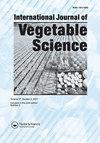Nitrate accumulation and physicochemical characteristics of lettuce as affected by sodium selenite and synthesized selenium nanoparticles
IF 1.1
Q2 Agricultural and Biological Sciences
引用次数: 1
Abstract
ABSTRACT Exogenous selenium (SE) application during lettuce (Lactuca sativa L.) production may prevent Se deficiency. Low concentrations of Se have beneficial effects on plant cell metabolism and application of Se can increase growth, yield, and quality and reduce nitrate concentration in lettuce. In the present study, biosynthetic synthesis of selenium (Se) nanoparticles (NPs) was carried out via Se ions reduction during exposure to rosemary (Salvia rosmarinus Spenn.) extract. Using scanning electron microscopy (SEM), the shape and size of the Se NPs were determined. To investigate effects of concentrations of sodium selenite (1, 2, and 4 mg∙L−1) and Se NPs (1, 2, and 4 mg∙L−1) on morphological and physiochemical traits of lettuce. Most nutrient solutions, especially 2 mg∙L−1 Se NPs, increased plant height, leaf number, fresh weight, chlorophyll a, total chlorophyll, and nitrate reductase activity of plants. Application of 2 and 1 mg∙L−1 Se NPs, caused a decrease in the level of nitrate accumulation. Under nutrient treatments, concentrations of P, K, Fe, Zn, and Se, and concentration of N decreased. Foliar application of biosynthetic synthesized Se NPs, may have potential for improved quantity and reduced nitrate accumulation in lettuce.亚硒酸钠和合成硒纳米粒子对生菜硝酸盐积累及理化特性的影响
摘要莴苣生产过程中外源硒(SE)的施用可以预防硒缺乏。低浓度硒对植物细胞代谢有有益影响,施硒可促进生菜生长、产量和品质,降低硝酸盐浓度。在本研究中,通过暴露于迷迭香(Salvia rosmarinus Spenn.)提取物中的硒离子还原,进行了硒(Se)纳米粒子(NPs)的生物合成。利用扫描电子显微镜(SEM)测定了Se纳米粒子的形状和大小。研究亚硒酸钠浓度(1、2和4 mg∙L−1)和硒NPs浓度(1、2和4 mg∙L−1)对生菜形态和理化性状的影响。大多数营养液,特别是2 mg∙L−1 Se NPs,增加了植株的株高、叶数、鲜重、叶绿素a、总叶绿素和硝酸盐还原酶活性。施用2和1 mg∙L−1 Se NPs导致硝酸盐积累水平下降。在养分处理下,磷、钾、铁、锌、硒的浓度和氮的浓度降低。叶面施用生物合成硒NPs可能有提高生菜产量和减少硝酸盐积累的潜力。
本文章由计算机程序翻译,如有差异,请以英文原文为准。
求助全文
约1分钟内获得全文
求助全文
来源期刊

International Journal of Vegetable Science
Agricultural and Biological Sciences-Plant Science
CiteScore
3.10
自引率
0.00%
发文量
30
期刊介绍:
The International Journal of Vegetable Science features innovative articles on all aspects of vegetable production, including growth regulation, pest management, sustainable production, harvesting, handling, storage, shipping, and final consumption. Researchers, practitioners, and academics present current findings on new crops and protected culture as well as traditional crops, examine marketing trends in the commercial vegetable industry, and address vital issues of concern to breeders, production managers, and processors working in all continents where vegetables are grown.
 求助内容:
求助内容: 应助结果提醒方式:
应助结果提醒方式:


